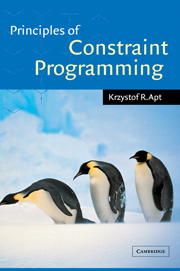Book contents
- Frontmatter
- Contents
- Acknowledgements
- 1 Introduction
- 2 Constraint satisfaction problems: examples
- 3 Constraint programming in a nutshell
- 4 Some complete constraint solvers
- 5 Local consistency notions
- 6 Some incomplete constraint solvers
- 7 Constraint propagation algorithms
- 8 Search
- 9 Issues in constraint programming
- Bibliography
- Author index
- Subject index
9 - Issues in constraint programming
Published online by Cambridge University Press: 15 December 2009
- Frontmatter
- Contents
- Acknowledgements
- 1 Introduction
- 2 Constraint satisfaction problems: examples
- 3 Constraint programming in a nutshell
- 4 Some complete constraint solvers
- 5 Local consistency notions
- 6 Some incomplete constraint solvers
- 7 Constraint propagation algorithms
- 8 Search
- 9 Issues in constraint programming
- Bibliography
- Author index
- Subject index
Summary
IN THE PREVIOUS chapters we discussed various aspects of constraint programming. We did it by concentrating on the relevant ingredients of this programming style separately. In principle we could put them together using the general framework of Section 3.2. There are, however, other issues that naturally arise when one tries to incorporate these techniques in a programming language or system. In this chapter we shall discuss these matters and also shed light on the resulting programming style. At the same time we shall provide a short summary of various research topics currently pursued in constraint programming.
We discuss in turn the issues concerned with modeling (in Section 9.1), constraint programming languages (in Section 9.2), constraint propagation (in Section 9.3), constraint solvers (in Section 9.4), search (in Section 9.5) and over-constrained problems (in Section 9.6). Finally, at the end of the chapter, in the bibliographic remarks, we provide pointers to a number of useful surveys that should allow the reader to embark on research in constraint programming. As the final bibliography is just ‘next door’ we do not list the, rather extensive, list of references at the end of this chapter.
Modeling
Recall that in Chapter 1 we formulated the following principle:
Constraint programming is about a formulation of the problem as a constraint satisfaction problem and about solving it by means of domain specific or general methods.
Information
- Type
- Chapter
- Information
- Principles of Constraint Programming , pp. 351 - 386Publisher: Cambridge University PressPrint publication year: 2003
Accessibility standard: Unknown
Why this information is here
This section outlines the accessibility features of this content - including support for screen readers, full keyboard navigation and high-contrast display options. This may not be relevant for you.Accessibility Information
- 1
- Cited by
